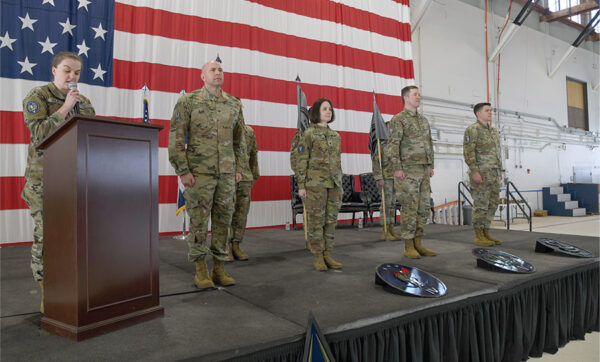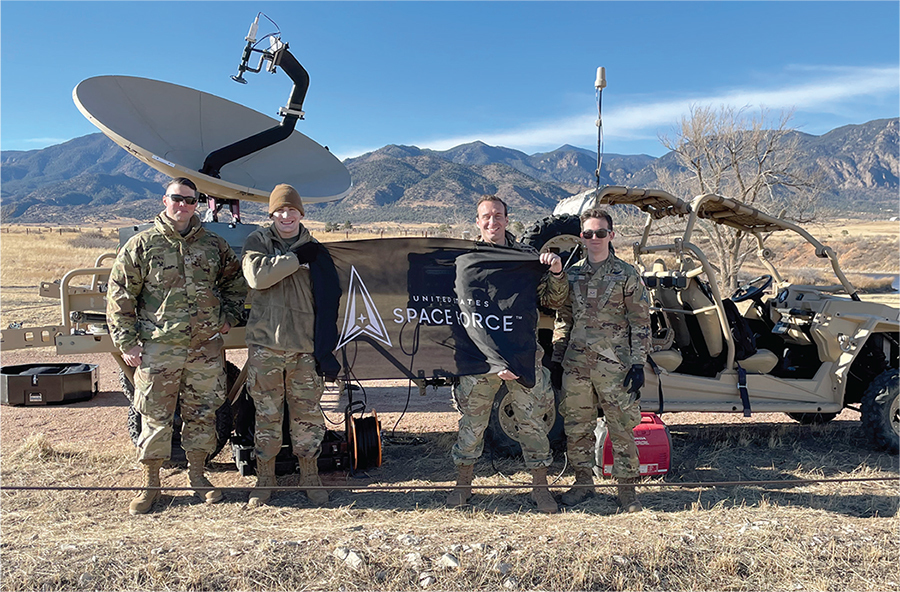
Editor’s Note: This article was originally published in the October 2022 issue of JED. To read past issues in full, visit our magazine archive.
Today, space is without question a critical operational domain for US military forces and one in which superior military capabilities and operational dominance must be assured. Speaking before the Senate Armed Service Committee in September, incoming US Space Force Chief Lt Gen Bradley Saltzman told the committee members, “The most immediate threat, in my opinion, is the pace with which our strategic challengers, first and foremost, the Chinese, are aggressively pursuing capabilities that can disrupt, degrade and ultimately even destroy our satellite capabilities and disrupt our ground infrastructure. It is one of my earliest priorities to make sure that we’re on track to build and field effective capabilities and then train the Guardians to operate in a contested [Space] domain so that we can counter this activity by our strategic competitors.”
Earlier this year, speaking at the 37th Space Symposium in Colorado Springs, CO, US Space Force Chief of Space Operations Gen John W. “Jay” Raymond also emphasized this point stating that, “The cornerstone to US security and prosperity is keeping space accessible, stable and secure. That is why the US, its allies and most of all, the United States Space Force, must move aggressively to modernize space hardware and re-orient thinking and practices in the domain.”
Clearly, an essential element of assuring US dominance in the space domain is achieving and maintaining parallel assured dominance of the electromagnetic spectrum (EMS). And this is where Space Force’s Space Delta 3 (DEL 3) organization comes to the fore.

SPACE DELTA 3
To understand the role and mission responsibilities of Space Delta 3, it’s helpful to describe where it falls within the overall organizational structure of US Space Force (USSF). In order of hierarchy, the USSF echelons are named field commands, deltas and squadrons. There are three field commands aligned with specific mission focuses: Space Operations Command (SpOC), Space Systems Command (SSC), and Space Training and Readiness Command (STARCOM). SpOC and SSC are commanded by three-star general officers, while STARCOM is led by a two-star.
In the press release announcing the new organizational structure, Space Force outlined that SSC, currently under Lt Gen Michael A. Guetlein, will be “responsible for developing, acquiring, and fielding lethal and resilient space capabilities for warfighters. Additionally, SSC will be responsible for launch, developmental testing, on-orbit checkout, and sustainment and maintenance of USSF space systems, as well as oversight of USSF science and technology activities.” STARCOM’s role, currently under Maj Gen Shawn Bratton, will be to “train and educate space professionals, and develop combat-ready space forces to address the challenges of the warfighting domain of space.”
Space Delta 3 falls within the third field command – SpOC – under Lt Gen Stephen Whiting. In October 2020, SpOC was the first field command to be activated, as “the primary force provider of space forces and capabilities for combatant commanders, coalition partners, the joint force and the Nation.” With headquarters at Peterson AFB, (Colorado Springs, CO), it was formed primarily from a combination of the former 14th Air Force and Air Force Space Command units. Under SpOC are a number of mission-oriented, numbered “Delta” units, sometimes described as similar in size and scope to Brigades in the Army.
Among the Delta units, Space Delta 3 (DEL 3) is heavily focused on Electromagnetic Spectrum Operations (EMSO). With personnel deployed worldwide, Space Delta 3 is responsible for “preparing and presenting assigned and attached forces to execute electromagnetic warfare (EW).” As further described by Maj Rachel Harris, Director, Space Delta 3 Commander’s Action Group, their mission is to “provide combat-level professionals able to be sent downrange to support joint fires by providing EW effects to those forces.” Space Delta 3 currently has north of 400 personnel, but Major Harris, says they “expect to boost up to between 500-600 personnel within the next year.” Within Space Delta 3, there are currently four squadrons – the 4th, 5th, and 16th operational Electromagnetic Warfare Squadrons (EWS), and the 3rd Combat Training Squadron (CTS), which evolved out of the 721st Operations Support Squadron (OSS). It is also augmented by Air National Guard and Air Force Reserve units.
Space Delta 3 is commanded by Col Christopher Fernengel, who says their number one priority is to build a foundation of competency in spectrum awareness and in integrating and synchronizing space EW into all-domain operations and fires. “In the past, with space operators working within the Air Force, if you asked them what they did, they would say ‘we operate a specific weapon system,’ but what we realized is that, while being competent on a particular weapon system is absolutely critical, it’s not enough.”
As a result, for Space Force’s EW Guardians, their focus is to develop EW professionals from the ground up. Says Fernengel, “After their initial Space Force training to become a Guardian, they jump right into spectrum awareness and EMS competency, and before they get into specific electromagnetic attack (EA), electromagnetic support (ES), or electromagnetic protection (ES) mission areas, we build them a solid foundation in overall spectrum awareness.”
Fernengel says a complementary and co-equal focus area for space EW professionals is to develop mission-planning-cell chiefs and operators capable of integrating and synchronizing with different combatant commands and different command and control elements to bring EW fires into all-domain-operation solutions. “The days of the Space EW stovepipe acting alone are over. Unless we’re able to effectively integrate and synchronize with all-domain fires, we will fail.”
In addition, Fernengel says they also prioritize strengthening the EW enterprise. “Some of the ways we do that include what I just mentioned as far as integrating and synchronizing operational command and control. As such, it involves coordinating with Director of Staff Space Forces (who have begun transitioning to Commander Space Forces [COMSPACEFORs]), with the different combatant commands, partnering on total force solutions between the Air Force, Air National Guard, and Air Force Reserves, as well as partnering with some of our sister Services that focus on EW like the Army’s 1st Space Brigade at Ft. Carson, CO.”
Also, in this regard, Fernengel highlights that there is a new organization under USSF called the Space Warfighting Analysis Center (SWAC) in Colorado Springs, CO. The SWAC is charged with all of Space Force’s future Force Design, including missile warning and tracking; wideband satellite communications (SATCOM); position, navigation, and timing (PNT) resilience; space domain awareness; intelligence surveillance and reconnaissance (ISR); and space superiority. Says Fernengel, “They’re charged with conducting the Force Design for all of our systems and capabilities coming out in the future. This includes not only the EMS but also the EW arsenal-of-the-future for the US.” As stated by General Raymond, “The first step in building more resilient space capabilities is designing the force you need… How many satellites, which payloads, in what orbits, and what ground infrastructure, to balance performance, cost and resilience? The Space Warfighting and Analysis Center helps us answer that question.”

SPACE DELTA 3 SQUADRONS
Each of the four squadrons within Space Delta 3 has a specific mission focus. Starting with the 4th EWS, its mission is to provide electromagnetic attack (EA) and electromagntic support (ES) operations. To achieve this, its primary weapon is currently the Counter Communication System (CCS). As described by Major Harris, the CCS provides “energy-on-energy brute-force jamming” of enemy satellite communications. 4th EWS is commanded by Lt Col Nicholas Shaw, the first officer to transfer from a Service (US Army) other than the Air Force to assume command of a Space Force unit.
According to Colonel Fernengel, prior to its re-designation in April, the 4th EWS was the Air Force’s 4th Space Control Squadron (4th SPCS). Prior to that, in the 2015/2016 timeframe, the 4th SPCS had combined with the Air Force’s 76th SPCS. “Both of those units had a long history with missions in EA and ES dating back to around the 2001 timeframe. So, over the course of about 21 years, they have been primarily expeditionary in nature and deployed all over the world.”
As per Space Delta 3’s overall mission priorities, Fernengel says the primary purpose of the 4th EWS is the integration and synchronization of its capabilities with all-domain fires. “This could include partnering with an airborne platform, such as the Air Force’s Compass Call, an Army Terrestrial EW capability, or shipborne capabilities from the Navy, and then having an integrated and synchronized battle plan to meet commander’s objectives.”
In November 2021, L3Harris Technologies (Melbourne, FL) announced it had received a $125 million contract for the “CCS Meadowlands” production program to upgrade 16 CCS Block 10.2 systems. According to the news release the “CCS Block 10.2, also developed by L3Harris, reached initial operating capability in March 2020, making it the first offensive weapon system accepted by the US Space Force.”
16th EWS
The 16th EWS, commanded by Lt Col Marshall Tillis provides ES operating its Bounty Hunter 2.0 system to provide electromagnetic interference (EMI) detection, characterization, and ultimately geolocation. Bounty Hunter 2.0 is a program of record (POR) for the 16th EWS and is continuously upgraded to improve its performance and capabilities. According to Fernengel, it is currently planned for upgrade to a Bounty Hunter 3.0 configuration over the next couple of years. “As recently as December, we did a major software upgrade to get benefits in terms of both effectiveness and efficiency.”
In addition to Bounty Hunter, the 16th EWS has also developed a commercial-off-the-shelf (COTS) version of the capability known as the Multiband Assessment of Communications Environment (MACE). As described by Major Harris, “It’s an innovative grass-roots program by the mission-assurance personnel of the 16th using funding that SpOC had at the end of FY2019/2020 to acquire COTS systems and build a smaller form factor equivalent of Bounty Hunter for EMI geolocation.”
Fernengel says the MACE system was developed in response to a perceived requirement and demand signal from users to be more agile and responsive. “While you lose some of the capacity and a little bit of the capability, the benefit is that, whereas it takes a C-5 or two C-17s to transport the Bounty Hunter system and supporting equipment, you can transport a MACE system in a pickup truck, or one aircraft pallet.” Harris adds another benefit is that MACE setup time is on the order of 30 minutes as opposed to the time to change a feed on a Bounty Hunter system which is on the order of hours.
Over the last several years, Space Delta 3 has invested funding in concept development, testing and exercises to determine if, going forward, MACE should be pursued as an independent program of record, as well as if there are some intellectual and capability benefits that can be gained and put into the requirements and acquisition strategy for the next iteration of Bounty Hunter 3.0. “For example,” notes Fernengel, “one of the benefits of the MACE system is that it is aperture agnostic, so you can actually take the system out and plug it into a user’s already-available apertures.”
In February 2021, the 16th EWS (then still 16th SPCS) participated in the Headquarters US Air Forces in Europe & Air Forces Africa joint, multi-national Combined Joint All Domain Command and Control (CJADC2) demonstration in the Baltic Sea region. Guardians from the 16th deployed with their MACE system during the demonstration and, as observed by the 16th commander at the time, Lt Col Angelo Fernandez, “It gave us a real-world opportunity to train and exercise with our coalition partners operating throughout various domains, gather lessons learned, and continue to improve our operations.”
At the time, Maj Gen Kimberly Crider, Space Force Chief Technology and Innovation Officer, now retired, said the demonstration showed that “investments in space capabilities increase the effectiveness of operations in every other domain – the US military and our allies are better connected, more informed, faster, and precise because of space. With the rise of near-peer adversaries, it is essential we build on space capabilities to ensure we maintain the competitive advantage with our joint and allied partners.”
380th SPCS
The Air Force Reserve 380th Space Control Squadron (SPCS), under Lt Col Andrew Buck (inbound October) is an associate unit to Space Delta 3’s 16th EWS. The squadron also works with the Bounty Hunter system to monitor satellite communications links to detect, characterize and geolocate satellite communications jammers, sources of interference and other signals of interest. Since the unit currently still belongs to the Air Force, however, it retains its SPCS nomenclature, as opposed to EWS.
5th EWS
The specific mission of Space Delta 3’s 5th EW Squadron, under Lt Col Alexander Courtney, is particularly sensitive, with Colonel Fernengel and Major Harris only willing to share that the unit “provides electromagnetic warfare capabilities and conducts EW missions.”
3rd CTS
Rounding out Space Delta 3’s complement of squadrons and capabilities is the 3rd Combat Training Squadron (CTS) under Lt Col Etan Funches. Formerly the 721st Operations Support Squadron (OSS), the 3rd CTS develops and trains combat relevant electromagnetic warfare professionals, providing the initial training for the Guardians who will eventually populate the operational squadrons, and continuation of advanced training during their tenure.
Joint Training and Quick Reaction Capabilities
Though each has a specific mission focus, all of the Space Delta 3 squadrons, other SpOC Deltas and the other field commands under Space Force, continue to work closely and often with each other. For example, Fernengel says that after CTS training and assignment to their Space Delta 3 operational squadrons, the Guardians continue to train together, exercise together and participate in advanced training events, such as Space Flag, Red Flag, Austere Challenge, Space Challenge, Talisman Sabre and various other exercises. Fernengel says they also have a lot of interaction with the other Deltas within SpOC. This usually comes in the form of advanced training events, one of which was the Space Flag exercise recently held at Shriever AFB, CO, and which Fernengel was the senior leader. “I was very impressed as we integrated and synchronized capabilities across the Space Force for all-domain effects to meet the commander’s intent.”
Space Delta 3’s squadrons also frequently interact and train with STARCOM’s Space Delta 11. Says Fernengel, “They provide entities that perform as space aggressors, and provide a battlefield in the form of a space range where we can practice high-end fighting in contested domains. We also partner with them on testing to bring on systems such as CCS Meadowlands and Bounty Hunter 3.0. They’re vital to the effective testing and checkout of those future systems.” Space Delta 3 also partners with SSC and its program offices for the CCS, Bounty Hunter as well as some of the QRC capabilities brought along through the Rapid Reaction Branch of SSC.
As pointed out by Fernengel, “In our role of building EW professionals, we’re in a unique position to provide quick reaction capabilities (QRC) and forces. When a component or combatant command requests an initial EW capability, we have the benefit of being able to reach across the four squadrons as well as the Space Delta 3 staff to posture and present professional EW forces. Although the squadrons traditionally deploy as a unit, for QRC missions, we have deployed personnel from across the different squadrons and Space Delta 3 staff in the form of a unified unit. It’s all based on the premise that we build EW professionals first.”
As observed by Major Harris, “It’s important to emphasize that Space Delta 3 is one of the only Deltas that deploys members. It’s truly the most expeditionary Delta within SpOC, and our individual teams are unique in that their capabilities service the Joint Force in not only a multitude of ways, but fit alongside the Joint Force, whereas a lot of the Deltas, while still providing effects, are separate from those effects and the users that are actually seeing them. Our operators are actually there with the Joint Force, and are having an impact all over the world.”
Summing up, Fernengel says, “The overarching theme that cannot be understated is that the EMS is less of a domain and is more of a battlefield that transcends all domains. What we’ve seen in history and in the news is that the EMS is critical to the US’s and our partners’ national security across all the elements of national powers, not just military but civilian markets, and basically the worldwide economy. So, Space Delta 3’s contribution is providing the EW fires for the US arsenal to protect and defend the EMS.”



